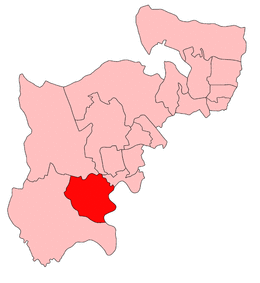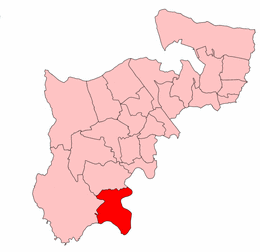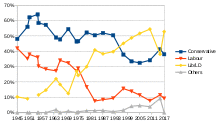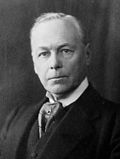| Twickenham |
|---|
Borough constituency
for the House of Commons |
 Boundary of Twickenham in Greater London |
| County | Greater London |
|---|
| Electorate | 79,172 (December 2010)[1] |
|---|
| Major settlements | Twickenham, Hampton and Teddington |
|---|
| Current constituency |
|---|
| Created | 1918 |
|---|
| Member of Parliament | Munira Wilson (Liberal Democrat)[2] |
|---|
| Number of members | One |
|---|
| Created from | Brentford |
|---|
Twickenham is a House of Commons constituency in South-West London, [n 1] represented in the House of Commons of the UK Parliament since 2019 by Munira Wilson of the Liberal Democrats.[n 2]
History
Since 1945, the boundaries of the seat have been similar to those of the abolished Municipal Borough of Twickenham.
From 1931 until 1983, Twickenham was a safe seat of the Conservative Party and from 1983 until 1997 a marginal seat for that party.
Liberal Democrat Vince Cable gained the seat during the 1997 landslide Conservative defeat and held it until 2015. The seat was one of very few in Britain that gave the Liberal Democrats a majority of votes in the 2005 and 2010 elections, being their sixth best performance nationally in 2010.[n 3] Cable was Secretary of State for Business from 2010 to 2015, but unexpectedly lost his seat to the Conservative candidate Tania Mathias in the 2015 general election during the nationwide collapse in the Liberal Democrat vote.
Cable regained the seat in the 2017 snap election by a 14.8% majority and an absolute majority at 52.8% of the vote; this was the highest vote percentage for the Liberal Democrats in any constituency nationally.[3]
The seat has in the 21st century had notably high turnouts. At the 2015 general election, it had the highest turnout in England and the fourth highest in the UK.[4] In 2017, turnout was 79.7%, the highest for any seat in the UK, ahead of Oxford West and Abingdon gained by the same party.[5][6] The seat of Twickenham has also been won by the same party as the neighbouring seat of Kingston and Surbiton in all seven elections they have been in (6 Lib Dem, 1 Conservative).
Boundaries

Hampton Court Palace

Twickenham in Middlesex, 1918–45

Twickenham, 1945–50
1918–1945: The Urban Districts of Heston and Isleworth, and Twickenham.
1945: boundaries substantially changed – losing territory in the north to form Heston and Isleworth, gaining territory from Spelthorne to the south including Hampton, Teddington, Hampton Wick, Hampton Court Park and Bushy Park
1945–1974: The Municipal Borough of Twickenham.
- Since 1974 formed from similar wards in the London Borough of Richmond upon Thames as follows:
1974–1983: Central Twickenham, East Twickenham, Hampton, Hampton Hill, Hampton Wick, Heathfield, South Twickenham, Teddington, West Twickenham, and Whitton.
1983–1997: Central Twickenham, Hampton, Hampton Hill, Hampton Nursery, Hampton Wick, Heathfield, South Twickenham, Teddington, West Twickenham, and Whitton.
1997–2010: Central Twickenham, East Twickenham, Hampton, Hampton Hill, Hampton Nursery, Hampton Wick, Heathfield, South Twickenham, Teddington, West Twickenham, and Whitton.
2010–present: The London Borough of Richmond upon Thames wards of Fulwell and Hampton Hill, Hampton, Hampton North, Hampton Wick, Heathfield, St Margaret's and North Twickenham, South Twickenham, Teddington, Twickenham Riverside, West Twickenham, and Whitton.
The seat covers the south western half of the London Borough of Richmond, that part of the borough on the north bank of the River Thames.[n 4] It chiefly contains the towns or London districts of Twickenham, Hampton, Teddington and Whitton. Smaller sub-localities by order of commercial activity are Hampton Hill, Hampton Wick, St Margarets, Fulwell, Strawberry Hill and Hampton Court hamlet proper.[n 5] Features includes Hampton Court Palace, Bushy Park (one of the Royal Parks of London), and the Rugby Football Union's national ground, Twickenham Stadium.
History of boundaries
- 1918–1945
During this period the Hamptons (Hampton, Hampton Hill, Hampton Court and Hampton Wick) and Teddington were excluded from the seat, which instead contained two urban districts to the north of subsequent boundaries, Isleworth and Hounslow, an area at the time with key economic sectors of construction, brewing, warehousing and goods transportation. As such these areas had some support for the Labour Party, who in their best result in the seat, lost the 1929 by-election in the seat by 503 votes (1.6% of the vote).
- 1945–date
In 1945, the area saw as an unusual corollary to its shift southwards, the swing nationally, of +11.7% (Con-to-Lab) converted in the more strongly middle-class redefined seat to a major cut in the 24% Conservative majority [n 6] swinging −15.3% to a Liberal opponent, George Granville Slack. In February 1974 and from 1979 until seizing victory in 1997, the runner-up party became the Liberal Party or their successor, the Liberal Democrats and the ward boundaries became only slightly adjusted to reflect changes made in the borderlines made at the local level of government.
Constituency profile
As described by the boundaries, the area enjoys substantial parkland and Thameside landscapes, coupled with a variety of commuter train services to Central London including semi-fast services from Twickenham itself to London Waterloo.
Twickenham is the only constituency situated entirely within the London Borough of Richmond upon Thames and, as such, is made up completely of middle-class suburbia, similar to the neighbouring constituencies of Kingston & Surbiton, Richmond Park (both in Greater London) and Esher & Walton in Surrey. Workless claimants, registered jobseekers, were in November 2012 significantly lower in Twickenham than the national average of 3.8%, at 1.7% of the population based on a statistical compilation by The Guardian.[7]
Members of Parliament
Elections

Results of UK House of Commons seat Twickenham since 1945 when substantially redrawn.
Elections in the 2010s
General election 2019: Twickenham[8] | Party | Candidate | Votes | % | |
| | Liberal Democrats | Munira Wilson | 36,166 | 56.1 | +3.3 |
| | Conservative | Isobel Grant | 22,045 | 34.2 | −3.8 |
| | Labour | Ranjeev Walia | 5,476 | 8.5 | −0.7 |
| | Brexit Party | Stuart Wells | 816 | 1.3 | New |
| Majority | 14,121 | 21.9 | +7.1 |
| Turnout | 64,503 | 76.3 | –3.2 |
| Registered electors | 84,906 | | |
| | Liberal Democrats hold | Swing | +3.6 | |
This was the second largest Lib Dem majority by percentage, after Bath and the largest by number. It was also their largest vote share at the 2019 general election.[9]
General election 2015: Twickenham[12][13] | Party | Candidate | Votes | % | |
| | Conservative | Tania Mathias | 25,580 | 41.3 | +7.2 |
| | Liberal Democrats | Vince Cable | 23,563 | 38.0 | −16.4 |
| | Labour | Nick Grant | 7,129 | 11.5 | +3.8 |
| | UKIP | Barry Edwards | 3,069 | 4.9 | +3.4 |
| | Green | Tanya Williams | 2,463 | 4.0 | +2.9 |
| | Christian | Dominic Stockford | 174 | 0.3 | New |
| | Magna Carta | David Wedgwood | 26 | 0.0 | New |
| Majority | 2,017 | 3.3 | N/A |
| Turnout | 62,004 | 77.3 | +2.5 |
| Registered electors | 80,250 | | |
| | Conservative gain from Liberal Democrats | Swing | +11.8 | |
See also: Opinion polling in United Kingdom constituencies, 2010–15 § Twickenham
General election 2010: Twickenham[14] | Party | Candidate | Votes | % | |
| | Liberal Democrats | Vince Cable | 32,483 | 54.4 | +2.7 |
| | Conservative | Deborah Thomas | 20,343 | 34.1 | +1.7 |
| | Labour | Brian Tomlinson | 4,583 | 7.7 | −3.7 |
| | UKIP | Brian Gilbert | 868 | 1.5 | 0.0 |
| | Green | Stephen Roest | 674 | 1.1 | −1.7 |
| | BNP | Chris Hurst | 654 | 1.1 | New |
| | Citizens for Undead Rights and Equality | Harry Cole | 76 | 0.1 | New |
| | Magna Carta | Paul Armstrong | 40 | 0.0 | New |
| Majority | 12,140 | 20.3 | +1.0 |
| Turnout | 59,721 | 74.8 | +2.4 |
| Registered electors | 80,569 | | |
| | Liberal Democrats hold | Swing | +0.5 | |
Elections in the 2000s
General election 2005: Twickenham | Party | Candidate | Votes | % | |
| | Liberal Democrats | Vince Cable | 26,696 | 51.6 | +2.9 |
| | Conservative | Paul Maynard | 16,731 | 32.4 | −1.0 |
| | Labour | Brian Whitington | 5,868 | 11.4 | −2.4 |
| | Green | Henry Leveson-Gower | 1,445 | 2.8 | 0.0 |
| | UKIP | Douglas Orchard | 766 | 1.5 | +0.3 |
| | Independent | Brian P. Gibert | 117 | 0.2 | New |
| | Rainbow Dream Ticket | George Weiss | 64 | 0.1 | New |
| Majority | 9,965 | 19.2 | +3.9 |
| Turnout | 51,687 | 71.8 | +5.4 |
| Registered electors | 71,444 | | |
| | Liberal Democrats hold | Swing | +2.0 | |
General election 2001: Twickenham | Party | Candidate | Votes | % | |
| | Liberal Democrats | Vince Cable | 24,344 | 48.7 | +3.6 |
| | Conservative | Nicholas Longworth | 16,689 | 33.4 | −4.4 |
| | Labour | Dean Rogers | 6,903 | 13.8 | −1.8 |
| | Green | Judith Maciejowska | 1,423 | 2.8 | New |
| | UKIP | Ray Hollebone | 579 | 1.2 | New |
| Majority | 7,655 | 15.3 | +8.0 |
| Turnout | 49,938 | 66.4 | −12.9 |
| Registered electors | 72,225 | | |
| | Liberal Democrats hold | Swing | +4.0 | |
Elections in the 1990s
General election 1997: Twickenham | Party | Candidate | Votes | % | |
| | Liberal Democrats | Vince Cable | 26,237 | 45.1 | +5.8 |
| | Conservative | Toby Jessel | 21,956 | 37.8 | −11.8 |
| | Labour | Eva Tutchell | 9,065 | 15.6 | +5.2 |
| | Independent English Conservative and Referendum | Jane Harrison | 589 | 1.0 | New |
| | Rainbow Dream Ticket | Terence D. Haggar | 155 | 0.3 | New |
| | Natural Law | Anthony J.W. Hardy | 142 | 0.2 | −0.1 |
| Majority | 4,281 | 7.3 | N/A |
| Turnout | 58,144 | 79.3 | -4.9 |
| Registered electors | 73,569 | | |
| | Liberal Democrats gain from Conservative | Swing | -8.8 | |
Elections in the 1980s
Elections in the 1970s
Elections in the 1960s
Elections in the 1950s
Elections in the 1940s
Elections in the 1930s
Elections in the 1920s

Joynson-Hicks
Elections in the 1910s
General election 1918 Twickenham[16] | Party | Candidate | Votes | % | |
| C | Unionist | William Joynson-Hicks | 14,015 | 83.2 | |
| | Labour | Humphrey Chalmers | 2,823 | 16.8 | |
| Majority | 11,192 | 66.4 | |
| Turnout | 16,838 | 48.2 | |
| Registered electors | 34,924 | | |
| | Unionist win (new seat) |
| C indicates candidate endorsed by the coalition government. |
See also
Notes and references
- Notes
- ^ A borough constituency (for the purposes of election expenses and type of returning officer)
- ^ As with all constituencies, the constituency elects one Member of Parliament (MP) by the first past the post system of election at least every five years.
- ^ By share of the vote, behind five seats: Orkney and Shetland, Westmoreland and Lonsdale, Bath, Yeovil, and Norfolk North
- ^ However mostly further south as the river is on a north-south axis at this point
- ^ An ill-defined but major neighbourhood of East Molesey often self-identifies as and ascribes to itself Hampton Court by virtue of its station and long standing sweep of shops of that name, across historic and actual boundaries, across the Thames in Surrey, this is not part of the Hampton Court hamlet mentioned.
- ^ Also known as one-party swing
- References
Sources
External links




